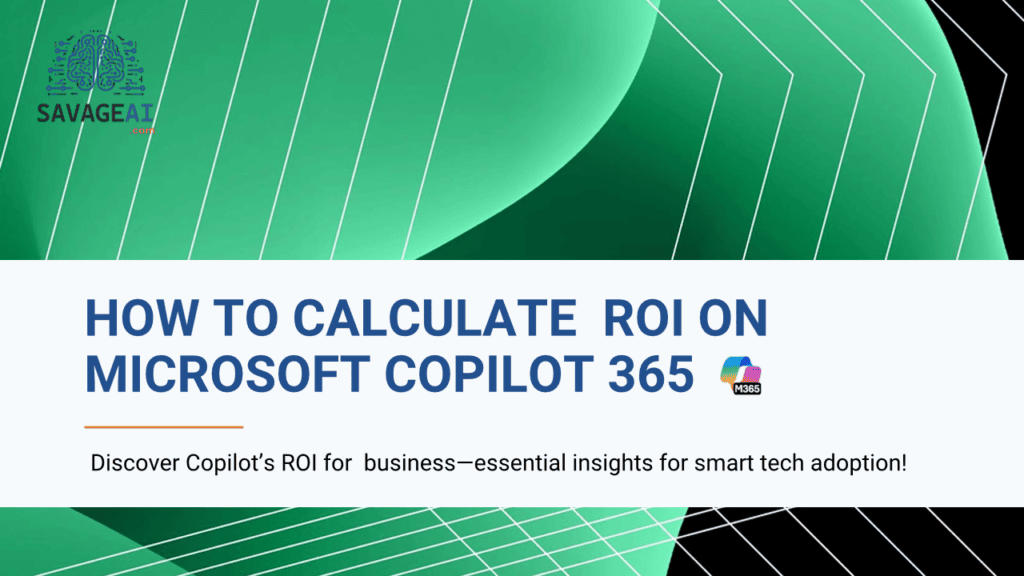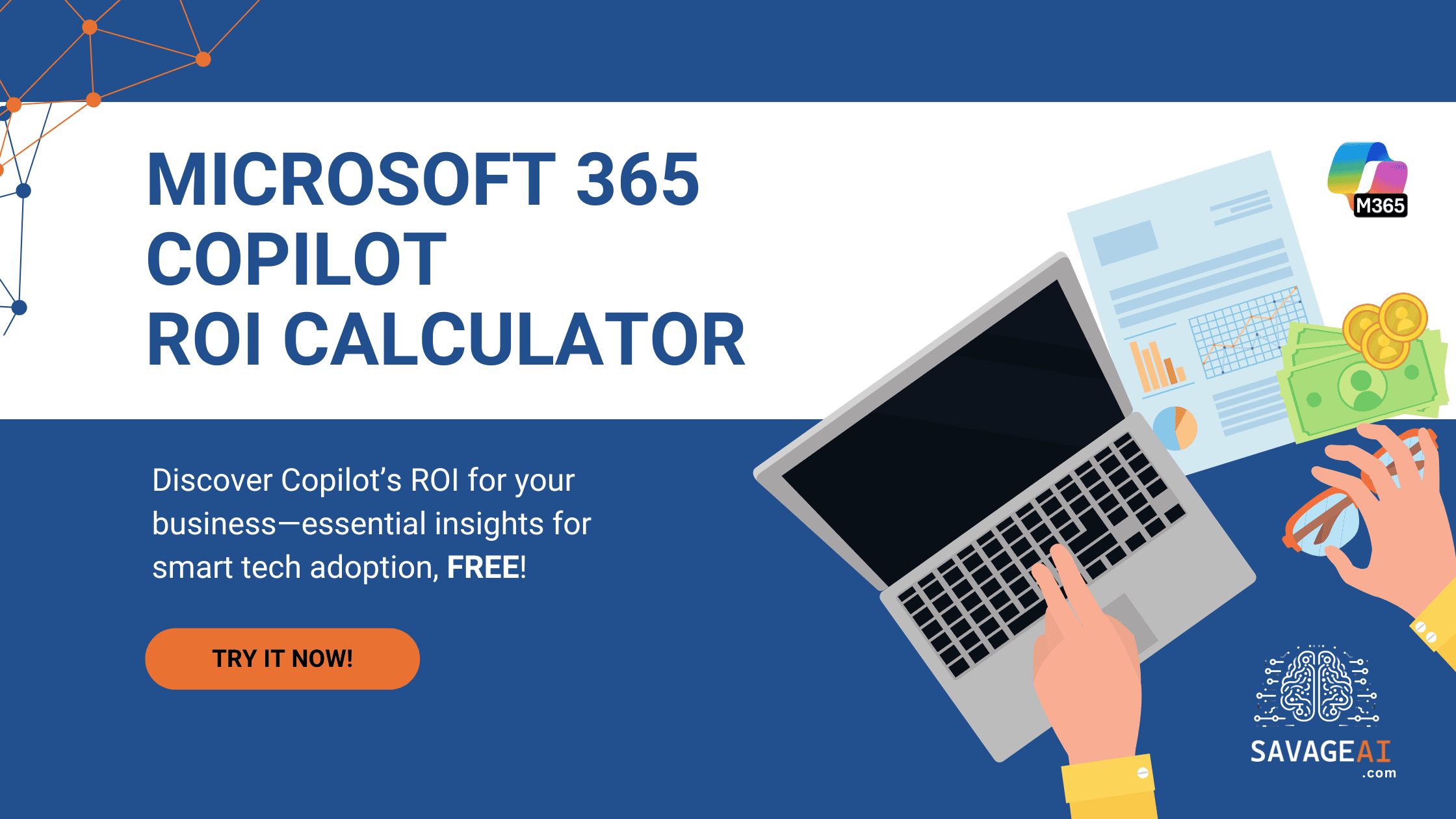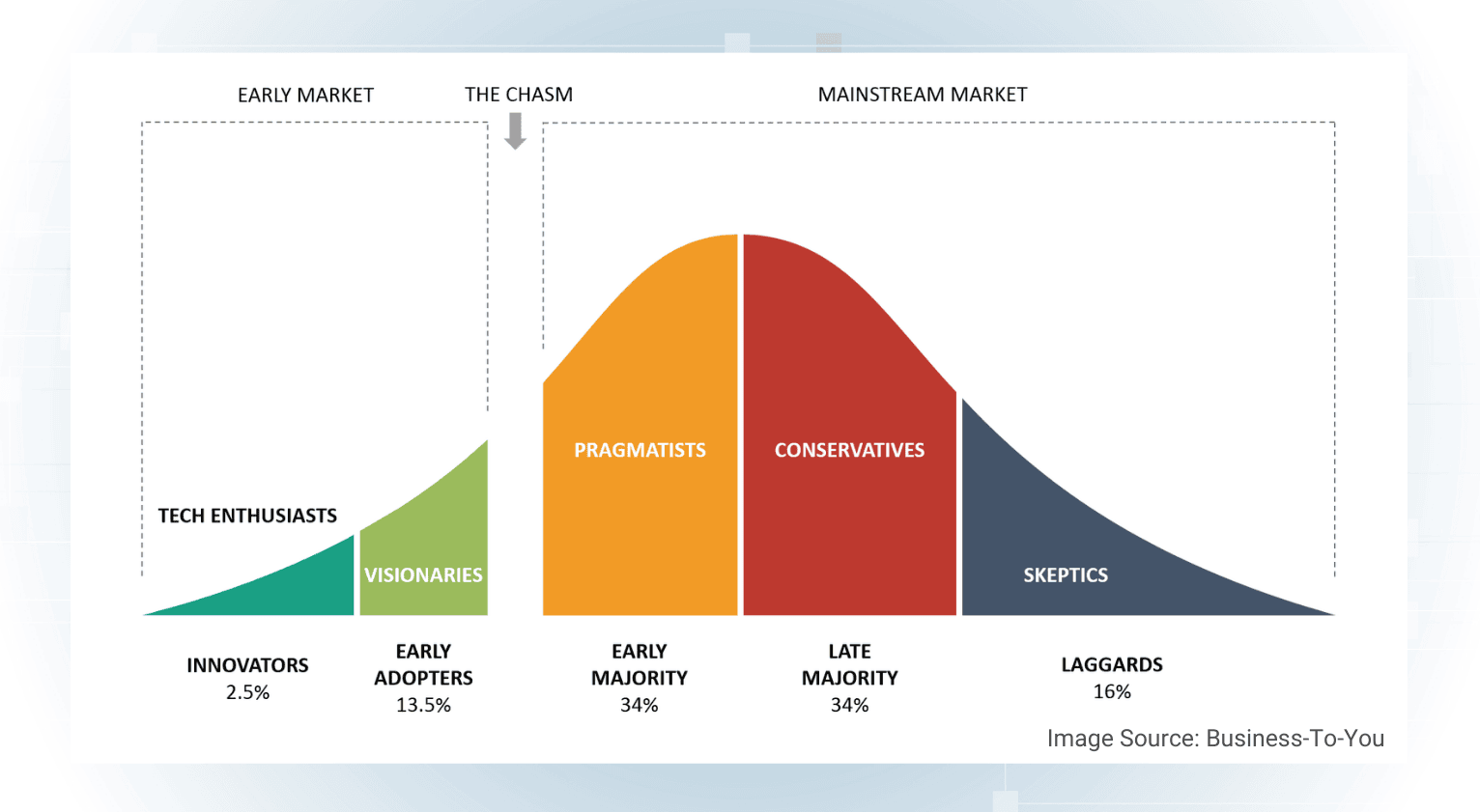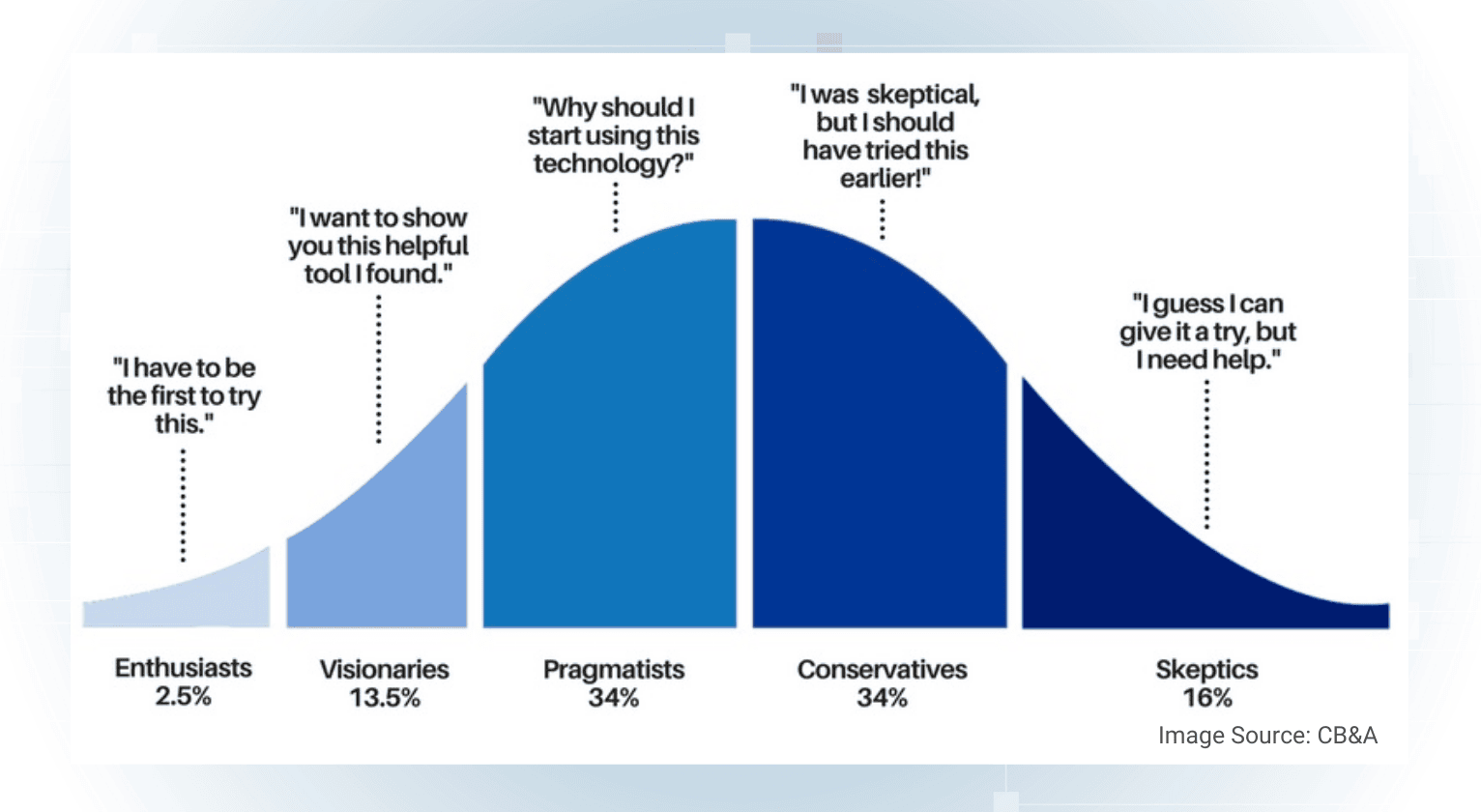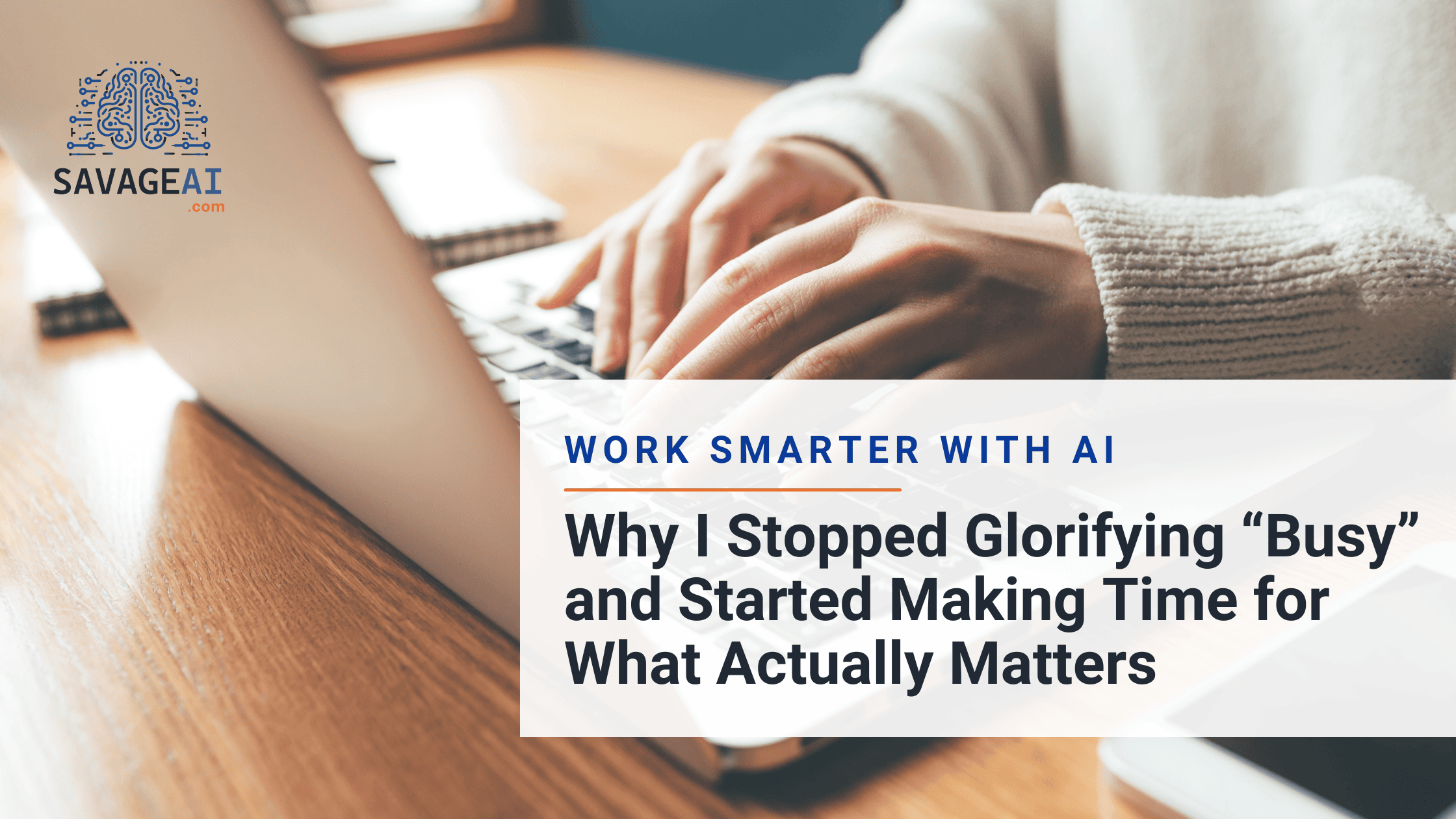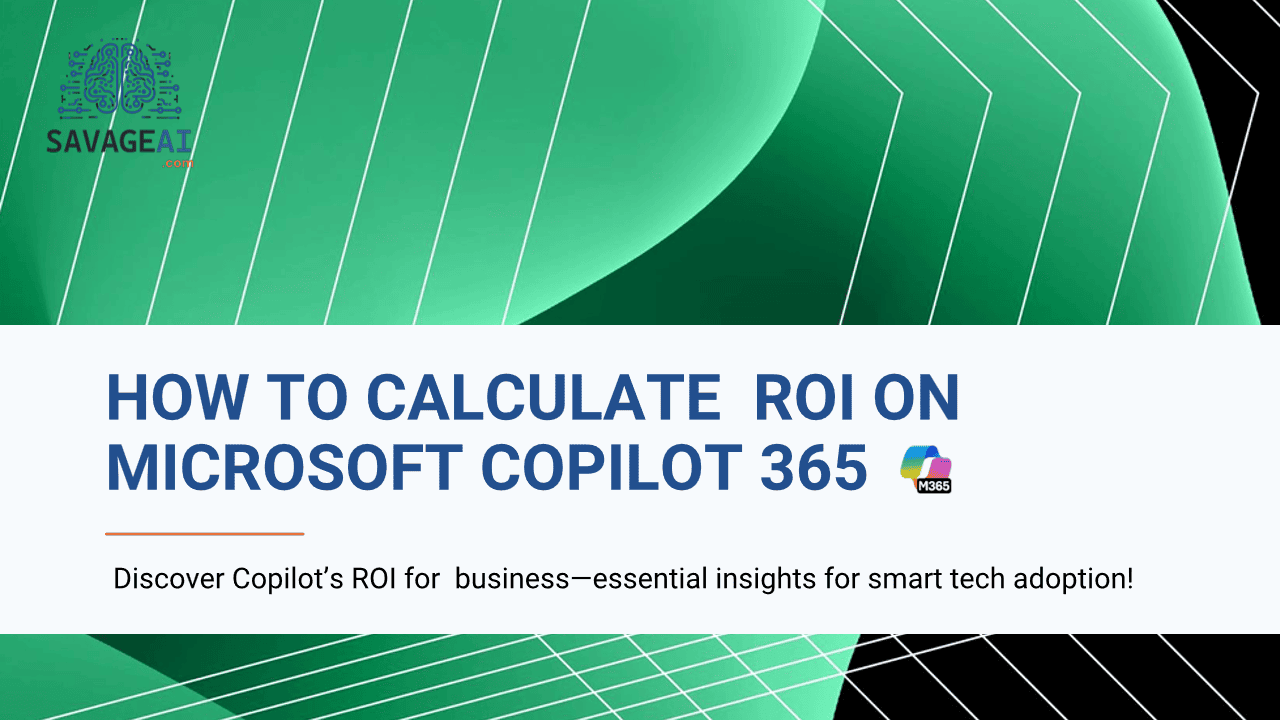Be in the know with SAVAGE AI News & Free Articles!
Your source for AI news and training options for your team!
Welcome to your ultimate source for cutting-edge AI news and insights! Dive into the world of Microsoft AI, where you’ll discover the latest advancements in Azure and Copilot. Stay informed about groundbreaking technologies like ChatGPT, Google Gemini, Apple Intelligence, and Meta AI. From Healthcare to Finance, Manufacturing to Customer Service, we are committed to finding and explaining the tools that are reshaping industries.
Join us as we navigate the future of artificial intelligence and its profound influence on our world and how we get work done. We will also focus on skills training that helps individuals, businesses, and organizations make practical use of these tools in a responsible way.
-
✴︎
How to Calculate ROI on Microsoft 365 Copilot
Wondering how to calculate ROI (return on investment) for implementing Microsoft 365 Copilot? You’re not alone—it’s a challenging task for many organizations. But don’t worry, we’re here to make it easier for you!
Table of Contents
What’s the ROI of Copilot for Microsoft 365?
That’s a great question, one that many organizations like yours are looking at seriously. The benefits of adding an AI assistant to your existing Microsoft tools (you know, Word, Excel, Outlook, Teams, etc.) that your employees use every single day seems like a no-brainer. Yet, most experienced decisions makers understand that IT projects have not always produce their promised payback.
Additionally, some still wonder if AI is just another fad. But you’re likely here because you see it as another game-changing technology, just like the emergence of PCs and the internet in the workplace were at the turn of the last century. And while I’ve covered that topic in detail in other blog posts, this article assumes you are convinced that it is, and want to start reaping the benefits before your organization is left behind trying to catch up.
So in this blog post, we will explore why calculating the return on investment (ROI) for implementing Microsoft 365 Copilot can be a challenging task for organizations, but also how they can do so successfully.
The Potential of Microsoft 365 Copilot
The potential of Microsoft 365 Copilot is substantial, as highlighted in the Forrester Consulting study commissioned by Microsoft. According to the New Technology: Projected Total Economic Impact Of Microsoft 365 Copilot for SMB report, businesses can experience a return on investment (ROI) ranging from 132% to 353% over a three-year period.
This impressive ROI is attributed to several key benefits, including faster time to market, increased productivity, and improved employee satisfaction. The study found that 24% of businesses experienced a 16% to 20% reduction in time to market for new products, and 27% saw improvements ranging from 11% to 15%
Moreover, the report emphasizes that investing in Copilot is not just about enhancing productivity but also about making a strategic investment for long-term growth. The study highlights a 6% increase in net revenue, a 20% reduction in operating costs, and a 25% acceleration in new-hire onboarding.
These transformative results demonstrate that Copilot can help businesses not only streamline their operations but also open doors to additional business opportunities and enhance their competitiveness in the market.
“Upskilling on AI now is absolutely critical to being prepared for its capabilities in a few years. In five years, running a business without Copilot would be like trying to run a company today using typewriters instead of computers.” – Forrester Study: Head Vice President of Technology Services, IT Services and Business Consulting
The Challenge of Calculating ROI
The complexity of calculating a good return on investment arises from three main factors: (1) the difficulty in calculating time saved, (2) understanding all the implementation costs, and (3) how you ensure adoption and use of the tool. In this blog post, we will explore these challenges and provide a framework for calculating ROI, along with two scenarios to illustrate the positive impact of employee training on the ROI. Each of these elements contributes to the overall investment required for a successful implementation.
I will use data derived from inputting multiple scenarios into our Microsoft 365 Copilot ROI Calculator to aid our discussion. You can then use our ROI Calculator yourself to see if the additional $30/user/month license cost is a smart investment for your organization.
The Difficulty In Calculating Time Saved
Calculating time saved can be challenging because it involves estimating the amount of time employees will save by using Microsoft 365 Copilot. In the article “What Can Copilot’s Earliest Users Teach Us About AI at Work?“, it was reported that 67% of users said Copilot saved them time so they could focus on more important work. On average, users reported daily time savings of 14 minutes, or 1.2 hours a week. Additionally, 22% of people said they save more than 30 minutes a day. While these surveys suggest significant time savings, we recommend using a conservative initial estimate of 14 minutes per day to ensure a realistic ROI calculation.
This cautious approach ensures a more realistic ROI calculation. To get a more accurate estimate, organizations can conduct their own surveys, asking employees to estimate how much time they spend in Excel, Word, PowerPoint, Outlook, and Teams each week. This baseline can be followed up post-implementation to calculate the actual time savings.
Organizations can input whatever number they want into our ROI calculator, but it’s important to emphasize that caution is warranted for a good ROI. By using the conservative estimate, we show that you can still obtain a great ROI, leaving it open for a post-implementation review to show an even greater ROI than anticipated.
Understanding All the Implementation Costs
As of the publishing of this article, I could not find many ROI tools for Microsoft 365 Copilot. Of the ones I did, they focused almost entirely on pitting the $30/user/month against estimated time savings.
There are, however, many other costs that need to be included to understand the first year’s investment (assuming that it is implemented in 1 year). Some of these include costs that I have seen firsthand, including IT costs in implementing the software.
While it is true that you simply need to purchase a number of Copilot licenses and apply them to Microsoft 365 accounts, that does not happen automatically. Nor does it ensure that all users are running the most recent version of Microsoft 365 on their PCs, including what is called “New Outlook”. In addition, IT costs vary from organization to organization. As such, our calculator allows you to input your IT costs, whether outsourced or a burdened labor rate and provides an estimate of how much time it takes per user to implement.
If you include employee training in the ROI calculation, it’s important to account for not only the training costs but also the time your employees spend attending the training sessions. Without accurately capturing all these costs, the ROI can be misleading and unrealistic, as it may not reflect the true investment required or the potential risks involved.
The Impact of the Adoption Curve
The adoption curve plays a significant role in determining the ROI of Microsoft 365 Copilot. Organizations that achieve higher adoption rates are more likely to realize the full benefits of the tool. However, achieving high adoption rates often requires a well-thought-out training plan. Without proper training, employees may not fully utilize the capabilities of Copilot, leading to lower productivity gains and a less favorable ROI.
In our previous blog post, The AI Adoption Curve: How to 3-5X Your ROI with Strategic AI Implementation, we discussed the Technology Adoption Curve introduced by Everett Rogers, which segments users into five distinct categories: Innovators, Early Adopters, Early Majority, Late Majority, and Laggards. The first two groups—Innovators and Early Adopters—make up only 16% of your workforce. If you rely solely on them to lead AI adoption, you risk leaving behind the other 84%, resulting in underutilized tools, wasted investment, and slower digital transformation. However, with structured training, you can increase the adoption rate to 84%, ensuring that the majority of your workforce is effectively utilizing the tool and contributing to a positive ROI.
I frequently engage with various organizations and employees. Among those who have implemented Microsoft 365 Copilot, many have not invested in upskilling their workforce. Consequently, as Everett Rogers predicted in 1962, the majority of these employees report either never using the tool or trying it but not achieving the desired results, both of which can be attributed to a lack of proper training.
Including Training in the Plan
Incorporating employee training into the implementation plan is crucial for maximizing the ROI of Microsoft 365 Copilot. Training helps employees understand how to use the tool effectively, leading to higher adoption rates and greater productivity gains. In short, don’t forget your humans. Your employees are still your most valuable resource. Despite the media hype, AI rarely replaces employees. This is because AI can not replace natural talent, years of experience, and complex discernment that only comes from a combination of both. In addition, they are often need to do final reviews of AI generated content. It does however work great as an assistant (or Copilot) saving knowledge workers substantial time each day, with the potential savings increasing as the technology improves.
AI can not replace natural talent, years of experience, and complex discernment that only comes from a combination of both.
While employee training comes at an additional cost, the long-term benefits often outweigh the initial investment. Once training is introduced, a higher adoption rate becomes assured. Even with conservative estimates of time saved per employee, the ROI that includes training costs is compelling enough to encourage organizations to implement Microsoft 365 Copilot sooner rather than later.
Forward-thinking organizations recognize that their employees are eager to use AI and can envision the significant contributions their experienced talent will make in advancing new initiatives and projects when supported by tools like Copilot. To illustrate the impact of employee training on your ROI, let’s consider some scenarios:
Scenarios 1: Rolling out Microsoft 365 Copilot to 100 employees without training
In this scenario, we used the default parameters, as explained in the calculator and mentioned above. Here are the results for 100 users without training:
Number Of Copilot Licenses 100 Total Investment $37,250 Hours Saved / Week / Employee 1.2 Total Cost Savings $23,003 Return on Investment (ROI) -$14,247 ROI Rate -38% Are you surprised that implementing Copilot without training results are a negative ROI? Most are, as they understand that Microsoft 365 Copilot is the future of Office productivity, and can see the potential benefits so clearly. Yet as we’ve discussed, a good ROI does not hide costs, and mitigates all risks.
The risk considered in this scenario is the technology adoption curve. First described in 1962 by Everett Rogers in his book ‘Diffusion of Innovations,’ it shows that without specific intervention, only 16% of employees will adopt new technologies and methods. This means that simply licensing Microsoft 365 Copilot and distributing training materials is unlikely to result in adoption rates above 16%. So you can only take the savings in hours per week against that percentage of your licensed workforce that actually start using the tools. It’s simple, most employees do not do this on their own.
Does training really have that much impact on adoption?
Scenarios 2: Rolling out Microsoft 365 Copilot to 100 employees with training
In this scenario, we again used the default parameters, as explained in the calculator and mentioned above. However, notice the difference in the results for 100 users with training:
Number Of Copilot Licenses 100 Total Investment $105,182 Hours Saved / Week / Employee 1.2 Total Cost Savings $120,766 Return on Investment (ROI) $15,584 ROI Rate 15% Notice that even with a significant increase in cost due to the inclusion of employee training costs, the overall ROI is now positive! By choosing to provide comprehensive training, you’ve effectively increased the adoption rate of Microsoft 365 Copilot to 84%, as opposed to the mere 16% adoption rate without such intervention. This higher adoption rate translates directly to greater efficiency, productivity, and ultimately, cost savings for your business.
Scenarios 3: Rolling out Microsoft 365 Copilot to 100 employees with training and increase savings per day
Yet as discussed above, your total cost savings are potentially double the 14 minutes per day we are estimating. According to many studies, users are reporting closer to 30 minutes per day in savings by using Copilot. How does that impact our ROI calculations?
Number Of Copilot Licenses 100 Total Investment $105,182 Hours Saved / Week / Employee 2.5 Total Cost Savings $251,597 Return on Investment (ROI) $146,415 ROI Rate 139% For 100 employees, that’s 13,000 hours saved annually. Assuming an employee provides 2,000 hours per year, you’ll have freed up the equivalent of 6.5 employees per year. And this not just avoiding the cost of adding 6 new hires to accomplish your company initiatives. Think of what your experienced employees could accomplish, and how appreciated they will feel, having their talents fully realized as they contribute further to your company’s growth.
Scenarios 4: Rolling out Microsoft 365 Copilot to 100 employees with discounted group training
Another opportunity is group pricing on Copilot training for your employees. All training providers provide such discounts, and SAVAGE AI is no exception. So while we took a conservative approach thus far to the training costs by including the class at the retail price, your ROI will increase significantly with a group discount. Why not schedule a discovery call with us to discuss your needs and find out how much you can save on training.
Number Of Copilot Licenses 100 Total Investment $95,282 Hours Saved / Week / Employee 2.5 Total Cost Savings $251,597 Return on Investment (ROI) $156,315 ROI Rate 164% Conclusion
When calculating ROI, it’s crucial to consider risk factors and how to mitigate them. Without proper employee training, you risk low adoption rates, which can dilute your ROI. Our free ROI Calculator tool allows you to use your own estimates and costs to get a realistic picture. And SAVAGE AI is ready to help your organization succeed in your adoption of Microsoft 365 Copilot by offering group pricing.
By understanding the challenges of measuring ROI, the impact of the adoption curve, and the importance of employee training, organizations can make informed decisions and maximize the value of their investment in Microsoft 365 Copilot. Investing in training ensures a smooth implementation process and demonstrates the value of a well-planned adoption strategy. Keep leveraging the full potential of Microsoft 365 Copilot to drive your business forward!
-
✴︎
The AI Adoption Curve: How to 3-5X Your ROI with Strategic AI Implementation
Businesses are pouring millions into AI, yet most struggle to see real returns. Want to know the secret to turning your AI investment into a 3-5x ROI? Discover how strategic adoption using the AI Adoption Curve makes all the difference.
Artificial Intelligence is no longer a futuristic concept; it is here, revolutionizing businesses across industries. However, simply investing in AI tools like Microsoft Copilot does not guarantee success. Without proper training and structured adoption strategies, most employees will either ignore or resist the technology. The key to maximizing return on investment (ROI) on AI investments lies in understanding the AI Adoption Curve and addressing the needs of every group within your workforce (Rogers, 1962).
Table of Contents
Understanding the AI Adoption Curve
The Technology Adoption Curve, originally introduced by Everett Rogers, segments users into five distinct categories:
- Innovators (2.5%) – The earliest adopters who experiment with new technology before anyone else.
- Early Adopters (13.5%) – The visionaries who see the potential and are eager to integrate it into their workflow.
- Early Majority (34%) – The pragmatists who adopt once they see proven success.
- Late Majority (34%) – The conservatives who resist until the technology becomes the norm.
- Laggards (16%) – The skeptics who only adopt when they have no other choice (Moore, 1991).
The first two groups—Innovators and Early Adopters—make up only 16% of your workforce. If you rely solely on them to lead AI adoption, you risk leaving behind the other 84%, resulting in underutilized tools, wasted investment, and slower digital transformation (Westerman et al., 2014).
Why Enthusiasts and Visionaries Aren’t Enough?
Enthusiasts and visionaries are naturally inclined to explore AI and find ways to integrate it into their work. However, they represent a minority. The majority of employees—Pragmatists, Conservatives, and Skeptics—need more than just excitement about AI. They need guidance, training, and a clear path for practical implementation (Brynjolfsson & McAfee, 2017).
Without structured learning:
- Pragmatists won’t adopt AI unless they see proof of its effectiveness (Bughin et al., 2018).
- Conservatives will resist change unless adoption feels necessary and safe (Fountaine et al., 2019).
- Skeptics will avoid it entirely, often dismissing AI as unnecessary or overly complex (Gartner, 2020).
This is why training is essential—it bridges the gap between AI investment and effective utilization.
The Challenge of Pragmatists, Conservatives, and Skeptics
Unlike early adopters, the majority of your workforce is driven by evidence, necessity, and security. They don’t just need access to AI; they need structured education and reassurance. They need a training experience that eliminates fear, builds confidence, and demonstrates real-world value (Davenport & Ronanki, 2018).
Common adoption barriers include:
✅ Fear of AI replacing jobs (McKinsey, 2021)
✅ Lack of understanding of AI’s capabilities (PwC, 2022)
✅ Uncertainty on how AI integrates into existing workflows (Accenture, 2023)
✅ Resistance to change (Harvard Business Review, 2023)
Instructor-led training directly addresses these concerns by offering a guided, hands-on approach to AI adoption.
The Role of Instructor-Led Training in Driving Adoption
Imagine investing in a powerful AI tool like Microsoft Copilot but only seeing a small fraction of your team actually use it. The reality is, without structured training, that’s exactly what happens. Companies that fail to educate their employees on AI usage will see low engagement, wasted resources, and slower innovation (Bughin et al., 2018).
To maximize AI adoption and ROI, businesses must provide structured, instructor-led training that caters to all adoption groups. Here’s how:
🔹 Live Demonstrations & Hands-On Practice – Employees need to see AI in action, interact with it, and get immediate feedback (MIT Sloan, 2022).
🔹 Customized Use Cases – Training tailored to industry-specific needs ensures relevance (Capgemini, 2022).
🔹 Progressive Learning – A step-by-step approach makes adoption easier and less overwhelming (Gartner, 2023).
🔹 Interactive Q&A – Live sessions provide real-time answers to concerns, increasing confidence (Forrester, 2023).
🔹 Ongoing Support – Adoption doesn’t end after one session; continued guidance is key (Deloitte, 2023).
When employees feel confident using AI, businesses see increased productivity, streamlined workflows, and higher returns on investment.
Maximizing ROI Through AI Training
Investing in AI is a significant financial commitment, and without proper training, adoption rates can be as low as 10-20% across an organization. However, companies that provide structured training programs see adoption rates rise to 60-80%, leading to a 3-5x increase in ROI (McKinsey, 2021).
✅ Companies with AI training experience a 40% increase in productivity (PwC, 2022).
✅ Organizations that integrate AI training see a 30% improvement in decision-making efficiency (Accenture, 2023).
✅ Businesses leveraging AI through structured adoption programs report a 20-50% reduction in operational costs (Deloitte, 2023).
By prioritizing AI training, businesses ensure their technology investments translate into measurable financial gains, rather than becoming underutilized tools.
Learn AI with Us
AI isn’t a magic wand—it’s a tool, and like any tool, its value depends on how well it’s used.
The difference between companies that see mediocre results and those that achieve 3-5x ROI comes down to one thing: adoption. The question isn’t if you should invest in AI. It’s how you’ll make that investment count.
Ready to Bridge the Gap Between Investment and Impact?
At SAVAGE AI, we don’t just teach AI—we teach your team how to win with it.
Ready to turn your AI investment into real results? Let’s transform potential into performance—book your training today!The Future Is Hiring: 4 New Jobs Created by AI You’ve Probably Never Heard Of
Continue ReadingThink AI is taking jobs? Think again. Discover 4 fast-growing, high-demand careers created by AI—like Prompt Engineer and AI Workflow Designer—and how tools like Microsoft Copilot are opening doors for non-coders. The future of work is here. Are you ready?
Work Smarter with AI: Why I Stopped Glorifying “Busy” and Started Making Time for What Actually Matters
Continue ReadingWork Smarter with AI! Tired of burnout and hustle culture? Discover how I stopped glorifying “busy,” embraced AI, and finally started working smarter with more purpose and less stress. Table of ContentsThe Slow Burn of SuccessWhat “Busy” Really Costs UsWorking With AI, Not Against ItThe Research Behind Smarter WorkflowsResources to Help You Work SmarterIf you’re…
How to Calculate ROI on Microsoft 365 Copilot
Continue ReadingUse your own data and calculate an implementation ROI for Microsoft 365 Copilot with our FREE calculator.
The AI Adoption Curve: How to 3-5X Your ROI with Strategic AI Implementation
Continue ReadingBusinesses are pouring millions into AI, yet most struggle to see real returns. Want to know the secret to turning your AI investment into a 3-5x ROI? Discover how strategic adoption using the AI Adoption Curve makes all the difference. Artificial Intelligence is no longer a futuristic concept; it is here, revolutionizing businesses across industries.…
Top 10 AI Tech Companies of 2024
Continue ReadingArtificial Intelligence (AI) is transforming the way we live and work. Explore the top 10 AI tech companies that led the charge in 2024.
Microsoft — Responsible AI, Responsible Choice for Businesses
Continue ReadingYou keep hearing about artificial intelligence (AI). Did you know Microsoft has already integrated it into your Microsoft Office 365 apps?
See more articles…
Or browse by category…
- Free Articles (15)
- News (6)

